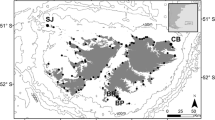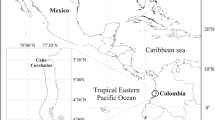Abstract
Antarctic plunderfishes are demersal species inhabiting the continental shelf of the Ross Sea, with sympatric distributions and similar morphology. Assuming these species are potential competitors for food, we aimed to quantify food overlap among them and to test the existence of factors involved in prey resource partitioning. Dietary composition and feeding niche breadth were estimated through stomach contents analysis of some species of Artedidraco sampled in the western Ross Sea. The fish community consisted of a wide range of feeders, from specialists like A. glareobarbatus and A. shackletoni, which fed exclusively on epifaunal polychaetes, to generalists like A. loennbergi and A. skottsbergi, which fed on a variety of prey. Although all species relied exclusively on benthic prey, diet diversity and prey type largely differed from each other, both contributing to reduce prey overlap and food competition. In a few cases, relatively high food overlap was observed between species with different spatial distributions. Based on our data and on previous studies, prey resource partitioning in plunderfishes is therefore established through morphological and behavioural adaptations, either by differential development of sense organs and trophic structures or by different diet composition and spatial distribution within the shared benthic habitat.



Similar content being viewed by others
References
Amundsen, P. A., H. M. Gabler & F. J. Staldvik, 1996. A new approach to graphical analysis of feeding strategy from stomach contents data – modification of the Costello (1990) method. Journal of Fish Biology 48: 607–614.
Clark, M. R., M. R. Dunn, P. J. McMillan, M. H. Pinkerton, A. Stewart & S. M. Hanchet, 2010. Latitudinal variation of demersal fish assemblages in the western Ross Sea. Antarctic Science 22: 782–792.
Clarke, K. R. & R. N. Gorley, 2001. PRIMER v5: User Manual/Tutorial. PRIMER-E, Plymouth.
Clarke, K. R. & R. M. Warwick, 1994. Change in Marine Communities: An Approach to Statistical Analysis and Interpretation, 2nd ed. PRIMER-E, Plymouth.
Costello, M. J., 1990. Predator feeding strategy and prey importance: a new graphical analysis. Journal of Fish Biology 36: 261–263.
Daniels, R. A., 1982. Feeding ecology of some fishes of the Antarctic Peninsula. Fishery Bulletin 80: 575–588.
Eakin, R. R., 1990. Artedidraconidae. In Gon, O. & P. C. Heemstra (eds), Fishes of the Southern Ocean. J.L.B. Smith Institute of Ichthyology, Grahamstown: 332–356.
Eastman, J. T., 1993. Antarctic Fish Biology: Evolution in an Unique Environment. Academic Press, San Diego.
Eastman, J. T., 2000. Antarctic notothenioid fishes as subjects for research in evolutionary biology. Antarctic Science 12: 276–287.
Eastman, J. T., 2005. The nature of the diversity of Antarctic fishes. Polar Biology 28: 93–107.
Eastman, J. T. & R. R. Eakin, 1999. Fishes of the genus Artedidraco (Pisces, Artedidraconidae) from the Ross Sea, Antarctica, with the description of a new species and a colour morph. Antarctic Science 11: 13–22.
Eastman, J. T. & R. R. Eakin, 2000. An updated species list for notothenioid fish (Perciformes; Notothenioidei), with comments on Antarctic species. Archive of Fishery and Marine Research 48: 11–20.
Eastman, J. T. & G. Hubold, 1999. The fish fauna of the Ross Sea, Antarctica. Antarctic Science 11: 293–304.
Eastman, J. T. & M. J. Lannoo, 2003. Anatomy and histology of the brain and sense organs of the Antarctic plunderfish Dolloidraco longedorsalis (Perciformes: Notothenioidei: Artedidraconidae), with comments on the brain morphology of other artedidraconids and closely related harpagiferids. Journal of Morphology 255: 358–377.
Ekau, W. & J. Gutt, 1991. Notothenioid fishes from the Weddell Sea and their habitat, observed by underwater photography and television. Proceedings of the NIPR Symposium on Polar Biology 4: 36–49.
Gerdes, D., B. Hilbig & A. Montiel, 2003. Impact of iceberg scouring on macrobenthic communities in the high-Antarctic Weddell Sea. Polar Biology 26: 295–301.
Gröhsler, T., 1994. Feeding habits as indicators of ecological niches: investigations of Antarctic fish conducted near Elephant Island in late autumn/winter 1986. Archive of Fishery and Marine Research 42: 17–34.
Hyslop, E. J., 1980. Stomach contents analysis – a review of methods and their application. Journal of Fish Biology 17: 411–429.
Hubold, G., 1991. Ecology of notothenioid fish in the Weddell Sea. In di Prisco, G., B. Maresca & B. Tota (eds), Biology of Antarctic Fish. Springer, Berlin: 3–22.
Iwami, T., H. Numanami & Y. Naito, 1996. Behavior of three species of the family Artedidraconidae (Pisces, Notothenioidei), with reference to feeding. Proceedings of the NIPR Symposium on Polar Biology 9: 225–230.
Klingenberg, C. P. & W. Ekau, 1996. A combined morphometric and phylogenetic analysis of an ecomorphological trend: pelagization in Antarctic fishes (Perciformes: Nototheniidae). Biological Journal of the Linnean Society 59: 143–177.
Kock, K. H., 1992. Antarctic Fish and Fisheries. Cambridge University Press, Cambridge.
La Mesa, M., R. Cattaneo-Vietti & M. Vacchi, 2006. Species composition and distribution of the Antarctic plunderfishes (Pisces, Artedidraconidae) from the Ross Sea off Victoria Land. Deep Sea Research II 53: 1061–1070.
Lecointre, G., C. Gallut, C. Bonillo, A. Couloux, C. Ozouf-Costaz & A. Dettaï, 2011. The Antarctic fish genus Artedidraco is paraphyletic (Teleostei, Notothenioidei, Artedidraconidae). Polar Biology 34: 1135–1145.
Linton, L. R., R. W. Davies & F. J. Wrona, 1981. Resource utilization indices: an assessment. Journal of Animal Ecology 50: 283–292.
Lombarte, A., 1999. External and internal morphology of the sensory organs in Artedidraconidae, Teleostei: Notothenioidei. Berichte Zur Polarforschung 301: 132–135.
Lombarte, A., I. Olaso & A. Bozzano, 2003. Ecomorphological trends in the Artedidraconidae (Pisces: Perciformes: Notothenioidei) of the Weddell Sea. Antarctic Science 15: 211–218.
Macdonald, J. A. & J. C. Montgomery, 1991. The sensory biology of notothenioid fish. In di Prisco, G., B. Maresca & B. Tota (eds), Biology of Antarctic Fish. Springer, Berlin: 145–162.
Marshall, S. & M. Elliot, 1997. A comparison of univariate and multivariate numerical and graphical techniques for determining inter- and intraspecific feeding relationships in estuarine fish. Journal of Fish Biology 51: 526–545.
McKenna Jr, J. E., 1991. Trophic relationships within the Antarctic demersal fish community of South Georgia Island. Fishery Bulletin 89: 643–654.
Near, T. J., A. Dornburg, K. L. Kuhn, J. T. Eastman, J. N. Pennington, T. Patarnello, L. Zane, D. A. Fernández & C. D. Jones, 2012. Ancient climate change, antifreeze, and the evolutionary diversification of Antarctic fishes. Proceedings of the National Academy of Sciences USA 109: 3434–3439.
Olaso, I., M. Rauschert & C. De Broyer, 2000. Trophic ecology of the family Artedidraconidae (Pisces: Osteichthyes) and its impact on the eastern Weddell Sea benthic system. Marine Ecology Progress Series 194: 143–158.
Ross, S. T., 1986. Resource partitioning in fish assemblages: a review of field studies. Copeia 2: 352–388.
Roughgarden, J., 1972. Evolution of niche width. The American Naturalist 106: 683–718.
Schoener, T. W., 1974. Resource partitioning in ecological communities. Science 185: 27–39.
Schwarzbach, W., 1988. Die Fischfauna des östlichen und südlichen Weddellmeeres: geographische Verbreitung, Nahrung und trophische Stellung der Fischarten. Berichte zur Polarforschung 54: 1–94.
Sokal, R. R. & F. J. Rohlf, 1995. Biometry. The Principle and Practice of Statistics in Biological Research. Freeman, San Francisco.
Targett, T. E., 1981. Trophic ecology and structure of coastal Antarctic fish communities. Marine Ecology Progress Series 4: 243–263.
Wyanski, D. M. & T. E. Targett, 1981. Feeding biology of fishes in the endemic Antarctic Harpagiferidae. Copeia 3: 686–693.
Zimmermann, C., 1997. Zur Ökologie arktischer und antarktischer Fische: Aktivität, Sinnesleistungen und Verhalten. Berichte zur Polarforschung 231: 1–137.
Acknowledgments
We are grateful to all crew members, personnel and scientific staff aboard of RV Italica for their support in sampling activities. We are also much indebted to Angelika Brandt, Ute Mühlenhardt-Siegel and Jurgen Guererro-Kommritz for taxonomic identification of prey. Finally, we thank two anonymous reviewers and the Editor-in-chief whose comments greatly improved the earlier draft of the manuscript. JT Eastman was supported by the National Science Foundation grant ANT-0436190. The study was financially supported by the PNRA (Italian National Antarctic Research Program).
Author information
Authors and Affiliations
Corresponding author
Additional information
Guest editors: Diego Fontaneto & Stefano Schiaparelli / Biology of the Ross Sea and Surrounding Areas in Antarctica
Rights and permissions
About this article
Cite this article
La Mesa, M., Castelli, A., Eastman, J.T. et al. Factors involved in prey resource partitioning in the genus Artedidraco (Notothenioidei, Artedidraconidae) from the western Ross Sea. Hydrobiologia 761, 249–259 (2015). https://doi.org/10.1007/s10750-015-2206-4
Received:
Revised:
Accepted:
Published:
Issue Date:
DOI: https://doi.org/10.1007/s10750-015-2206-4




